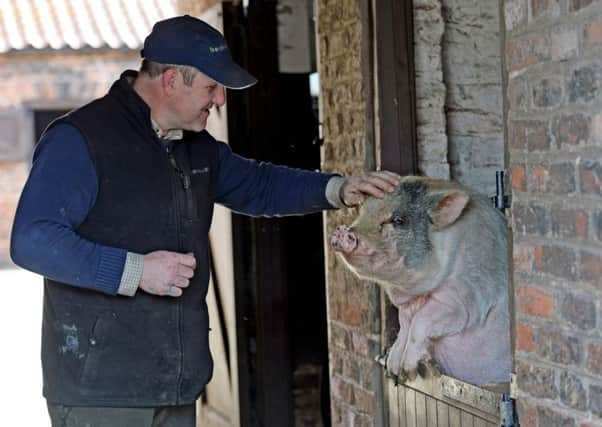New NFU chairman wants no nonesense approach to disease control


He has recently taken on the role of NFU North Riding and County Durham county chairman and has the bit firmly between his teeth.
Having been Stokesley branch chairman five years ago Martin, who farms in the village of Maltby between Yarm and Stokesley, hadn’t held another office until he was approached about taking on this role. He felt the timing was now right for him to step in.
Advertisement
Hide AdAdvertisement
Hide Ad“I’ve come in with a bit of an agenda. I’m desperate to keep Bovine TB out of the north of England so I’m attending every conceivable meeting to fly the northern flag about keeping it out.
“We need to make it socially unacceptable for animals to come in from dirty areas. Whoever is bringing stock in needs to be conscious of where it is coming from, ask questions including specifically what TB cycle that farm is in and tests need to be conducted both pre and post movement.
“A lot of the cases where Bovine TB has been discovered are on the back of animals brought in from dirty areas and that brings hardship not just to the farmer but also to their neighbours. It has caused quite serious neighbourly ructions and is avoidable by taking the right steps.
“I’m also passionate about working with the dairy sector to try and help resolve the on-going problem over supermarkets’ pricing and what they pay farmers.
Advertisement
Hide AdAdvertisement
Hide Ad“I joined the Stokesley branch of the NFU in the early 90s to pick up ideas and listen to good speakers. Two of the great things about the NFU are that it attracts fantastic industry professionals and organises appropriate visits to others’ farms and businesses, but we also need to tackle issues that affect us all.”
Martin believes upland farmers are dealt a poor hand the likes of national parks and the National Trust.
“Upland farmers and those based in national parks are not getting a fair bite of the cherry when it comes to being allowed to diversify. National parks don’t seem to understand that there are only so many bed and breakfast establishments and four wheel drive training centres you can have in an area before you need to look elsewhere for other income opportunities. Why are farmers in these areas not allowed to have wind turbines and solar panels?
“I have what could be described as a nice, viable unit across our two farms covering 320 acres here at Maltby Grange and Upper Farm in the next village in Thornton. My one wind turbine provides me with an additional income as well as all the electricity we need. I don’t see why upland farmers should not be able to derive a similar benefit.”
Advertisement
Hide AdAdvertisement
Hide AdMartin’s grandfather James Brecon came to Maltby in the 1920s and was a dairy farmer.
Martin regrets having been unable to bring back a milking herd: “It’s in my blood. Unfortunately granddad had to sell the cows when I was a boy due to his ill health. I milked them with him and would have loved to be a dairy farmer but when I came back from Askham Bryan College and looked at the figures it was a non-starter.”
Beef cattle are the nearest Martin gets to dairying. They play an increasing part in his farm operation at Maltby Grange with his suckler herd up to 140 Simmental X Hereford cows.
“Simmental is the base of the herd. It’s a very quiet breed and I have a real emphasis on temperament. It’s also a big, long, rangy cow that is a good milky mum.
Advertisement
Hide AdAdvertisement
Hide Ad“I’ve been using a Hereford bull on the heifers because I want a small easy calving process for them to start with. I have four bulls - two Herefords and two Simmentals. The stock I’m producing goes well at market and I sell pretty much all my cattle at Northallerton.”
Martin’s arable acreage is diminishing as cattle numbers grow but he currently grows 120 acres of wheat, as well as lucerne, red clover and barley.
“We grow varieties of wheat such as Revelation, Relay and JB Diego and it averages around 3.5 tonnes per acre. A lot of people grow oilseed rape but we grow lucerne and red clover to feed to the cows. They break the pan of the land up and are good nitrogen fixers. My son Tom is getting quite excited with spring corn at the moment. The new generation of farmers coming through are starting to see the benefits of ploughing land in the winter and sowing in really good conditions in the spring, saving on input costs and, in the case of barley, growing for shorter periods.”
Martin is a firm believer in wildlife and conservation: “I was planting and growing hedges long before stewardship schemes came long. I’ve planted miles of hawthorn hedges with holly in between but I now need to plant more as I’m cutting my field sizes. Hedges are a hub of wildlife and can also help with livestock. I’m convinced my losses during 2012/13 would’ve been far greater if my cows and calves had not been able to get behind a decent hedge.
Advertisement
Hide AdAdvertisement
Hide Ad“I’m also really pleased with the birds that come to the farm. We’ve always had lapwings, yellowhammers, skylarks, tree and house sparrows but now we have buzzards and we’re using a wild flower mix to encourage barn owls.”